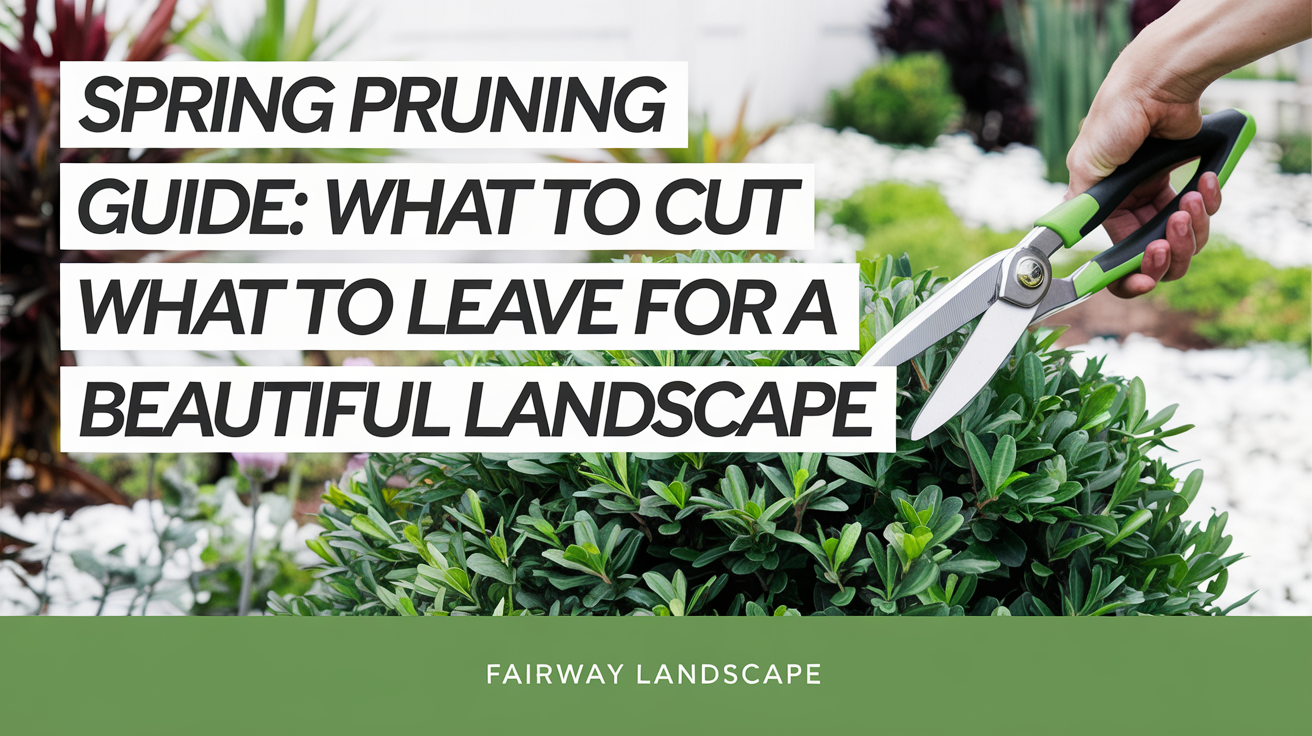As winter releases its grip and the first signs of spring emerge across Maryland, many homeowners reach for pruning tools with enthusiasm but without clear direction. This well-intentioned but often misguided spring ritual can damage plants, reduce flowering, and create long-term structural problems. Proper pruning requires understanding not just how to make cuts, but when to prune different plants and which should be left alone entirely during spring. With the right knowledge and techniques, spring pruning becomes a powerful tool for shaping beautiful, healthy landscapes rather than an exercise in hopeful guesswork.

Understanding Pruning Timing for Different Plants
Flowering time determines appropriate pruning windows. Plants that flower on “old wood” (buds formed the previous year) should not receive major pruning in spring, as this removes flower buds already set. These early-flowering shrubs—including azaleas, forsythia, and many hydrangea varieties—should be pruned immediately after flowering. Our professional pruning services schedule each plant for its optimal timing rather than convenience.
Growth cycle alignment maximizes plant response. Different plants break dormancy and begin active growth at different times. Pruning should align with these natural cycles—typically performed just before growth begins for maximum healing response. Our landscape pruning techniques account for these species-specific timing considerations rather than applying calendar-based rules across all plants.
Weather patterns influence optimal pruning windows. Late frosts can damage fresh pruning cuts and new growth that emerges after pruning. Our professional approach monitors weather forecasts and adjusts timing accordingly, particularly for sensitive species that respond quickly to pruning with vulnerable new growth.
Spring Pruning Priorities: What Needs Attention Now
Winter damage removal should top your spring pruning list. Broken, split, or damaged branches create entry points for diseases and pests while diverting energy from healthy growth. Our comprehensive spring assessment identifies this damage—often located high in the canopy where homeowners might miss it—and removes it using proper pruning techniques.
Dead wood elimination improves both health and appearance. Branches that failed to leaf out last season or show no signs of life as spring begins should be promptly removed. Our professional pruning services include thorough dead wood removal that improves plant energy allocation while reducing disease and pest habitat.
Crossing branch correction prevents future damage. Branches that rub against each other create wounds that invite disease entry. Early spring, before full leaf emergence, provides ideal visibility for identifying and correcting these structural issues. Our detailed approach addresses these problems while maintaining natural form and balance.
What Not to Prune in Early Spring
Spring-flowering shrubs should generally be left alone. Plants like azaleas, rhododendrons, forsythia, and many viburnums have already set their flower buds for this season. Pruning now removes these buds and eliminates this year’s flowering display. Our flowering shrub maintenance schedules these plants for attention immediately after their bloom period ends.
Oak trees require special seasonal consideration. To prevent oak wilt disease transmission, oak pruning should be avoided during active disease transmission periods (typically April through June in our region). Our professional pruning services schedule oak work during dormant winter months or late summer when disease risk is minimized.
Recently planted specimens need establishment time. Plants installed within the past year should receive only minimal pruning—removing damaged material while allowing the plant to establish its root system before directing energy to responding to pruning cuts. Our conservative approach with new plantings ensures successful establishment.
Professional Pruning Techniques for Landscape Plants
Proper cut placement significantly impacts healing and future growth. Cuts should be made just outside the branch collar (the swollen area where branch meets trunk or larger branch) without leaving stubs or cutting into the collar itself. Our professional pruning services utilize these precise techniques that promote rapid healing and minimize stress.
Thinning versus heading cuts produce dramatically different results. Thinning cuts remove entire branches back to their point of origin, maintaining the plant’s natural form while reducing density. Heading cuts shorten branches to arbitrary points, often resulting in unsightly “witches’ brooms” of dense new growth. Our approach emphasizes thinning cuts that preserve natural form while achieving desired size control.
Percentage guidelines prevent over-pruning stress. Even during appropriate timing windows, removing too much material can shock plants and trigger excessive compensatory growth. Our certified arborists follow the one-third rule—never removing more than one-third of a plant’s total mass during a single pruning session. This measured approach maintains plant health while still accomplishing necessary size control and structural improvement.
Specialized Approaches for Different Plant Types
Deciduous tree pruning focuses on structural development. For shade trees, spring pruning should emphasize removing competing leaders, establishing proper branch spacing, and eliminating weak attachments rather than size control. Our professional tree pruning develops strong structure that prevents future problems while maintaining natural form.
Evergreen pruning requires conservative approach. Most evergreens should receive minimal pruning, focused primarily on removing damaged material rather than significant shaping. Our specialized techniques for different evergreen types—from pines and spruces to broadleaf evergreens like hollies—respect their unique growth habits and limited ability to regenerate from old wood.
Perennial cutback timing varies by species. While some perennials benefit from fall cutback, many should be left standing through winter and cut back just as new growth emerges in spring. Our plant rejuvenation methods include species-specific timing for perennial cutback that balances aesthetic considerations with plant health and wildlife habitat value.
Rejuvenation Techniques for Overgrown Shrubs
Selective renewal pruning gradually restores plant health. For moderately overgrown shrubs, removing the oldest one-third of stems at ground level annually over three years creates complete renewal without sacrificing flowering or stressing the plant. Our professional approach implements this measured rejuvenation that maintains plant presence while gradually improving condition.
Complete rejuvenation suits certain resilient species. Some shrubs—including forsythia, spirea, and potentilla—respond well to complete cutback to 6-12 inches above ground during dormancy. Our experienced pruners identify appropriate candidates for this dramatic approach that quickly restores manageable size and vigorous growth.
Staged reduction addresses severely overgrown specimens. Plants that have far exceeded their appropriate size often require multi-year reduction programs rather than single-season correction. Our comprehensive management plans establish appropriate timelines and techniques for gradually bringing these plants back to manageable dimensions without risking their survival.
Tools and Techniques for Quality Results
Tool selection significantly impacts cut quality and plant health. Different pruning tasks require different tools—from bypass hand pruners for small branches to extension pole saws for higher work. Our professional pruning services utilize commercial-grade equipment appropriate for each specific task, maintained with razor sharpness that creates clean cuts that heal rapidly.
Disinfection protocols prevent disease transmission. Certain plant diseases can spread through pruning tools, making disinfection between plants or even between cuts on infected specimens essential. Our comprehensive approach includes appropriate sanitizing procedures based on specific disease concerns present in your landscape.
Safety considerations should guide pruning decisions. Homeowner pruning accidents account for thousands of emergency room visits annually. Our professional services include appropriate safety equipment, trained personnel, and specialized tools for accessing higher branches safely. This professional approach manages risk while achieving results beyond the reach of typical homeowners.
Post-Pruning Care for Optimal Recovery
Proper debris handling prevents disease cycles. Pruned material from diseased plants should be removed from the property rather than composted to prevent reinfection. Our complete pruning services include appropriate disposal of all generated material, leaving your property clean while breaking potential disease cycles.
Mulching supports recovery after significant pruning. A fresh layer of quality mulch helps retain soil moisture and moderate temperature fluctuations that might stress recently pruned plants. Our comprehensive services include appropriate mulching that supports recovery while enhancing landscape appearance.
Fertilization timing should complement pruning activities. Plants undergoing significant pruning benefit from appropriate nutrition that supports new growth development. Our integrated approach coordinates fertilization timing with pruning activities, providing balanced nutrition when plants are most responsive.

